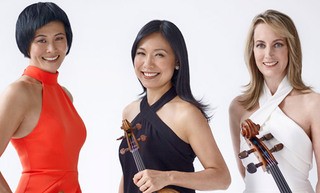|
Back
Clouds, Churches and Disembodied Auras New York
Laemmlien and Leah Buttenwieser Hall, 92nd Street Y
11/30/2016 -
“SoundSpace”:
Kaija Saariaho: Cloud Trio
György Kurtág: Selections from Signs, Games and Messages
Andrew Norman: The Companion Guide to Rome
Variation Trio: Jennifer Koh (Violin), Hsin-Yun Huang (Viola), Wilhelmina Smith (Cello)

J. Koh, H.-Y. Huang, W. Smith (© Courtesy of the Artists)
If the opening program of “SoundSpace” at the 92nd Street Y is typical, we New Yorkers will have more chances to discover the alliance of living composer with composition. The New York Philharmonic’s “Contact” series brings composer and audience together, National Sawdust frequently lets their chamber audience enjoy the talks of luminaries like Esa-Pekka Salonen (which are as anecdotal as they are educational). And last night, two of the three composers, luminaries in their own right, gave short talks about their music.
Not that Kaija Saariaho’s Cloud Trio or Andrew Norman’s The Companion Guide to Rome needed more than a few words. For we are no longer in the era of Boulez and Stockhausen. They have done their work in Darmstadt, they have offered us complex classics. But now we are in an era where The Dummy’s Guide to Post-Dodecaphonic Composition is no longer essential...or even needed.
Sounds and silences. Ms. Saariaho is being celebrated this week, since her opera has been opened at the Met. But this so prodigious, so fascinating composer needs no grand performance for celebration. Each work she gives us has its own enchantment. For just as she is allies herself with natural transformations of nature, we are fascinated by the evolving nature of her music.
I had heard the Cloud Trio in its New York debut several years ago, and it was elegiac. Here the four contrasting movements were provided by the Variation Trio in their New York debut. Violinist Jennifer Koh is a familiar recitalist here, but with her two strong companions, violist Hsin-Yun Huang and cellist Wilhelmina Smith, she was offered a chance to display as much exuberance and muscularity as possible.
For even with the supposed meditation of clouds in the French Alps, Ms. Saariaho brought forth a music of volition, energy, involvement. One heard this in the opening calm prayer of the opening movement. And while is never crass enough to paint literal pictures, the second movement here was obviously of cirrus clouds. Wispy, moving, fragmentary, leading to a movement where silence was as important as sound.
The Variation Trio gave an unalloyed strength to each section, especially with a strong theme by viola, a Hebraic theme which was totally original. Yes, the cello is the traditional “Jewish” instrument, but the viola is even rarer. Not just the sound or exoticism, but the fact that the viola doesn’t exactly “belong” anywhere.
Perhaps this is my imagination. But Ms. Saariaho gave us in Cloud Trio three overlapping layers. First, the music was obviously complex. Second, a group like the Variation Trio can made the sounds adhere to any brain. But third, like any great artist, Ms. Saariaho doesn’t tell us exactly what she means. We can indeed put forth our own imaginations.
That group gave us even more imagination with five of György Kurtág’s exhaustless Signs, Games and Messages. These are hardly movements. They are fragments, Zen koans, mini-bagatelles, dedications to friends and fellow artists or (here) Shadows or Ligatura Y. We began with a tiny cello solo and a big bang, going on with pizzicato Hungarian dances, soft and loud contrasts. Perhaps (like that Zen koan ) to prick the mind, to act as disembodied catalyst, to throw a musical petal in the air...
The longest section of SoundSpace, a concert with no intermission, was Andrew Norman’s The Companion Guide to Rome. I have heard several works of Mr. Norman–architect, violist, pianist, endlessly inventive composer–each of them expressing a joy, an explosion of sounds, music of enthrallment.
And this 30-minute work of nine sections, was his description of nine Roman churches. No religious motives, no Passion of the Christ. But the images of an architect. We may picture Saint Teresa as a mild saint, but here the church, according to Mr. Norman, was a combustible sound series from the three players. Just as Saint Peter’s Church in the Vatican took us out with glissandi and swirling colors.
Here too were solo movements for viola or violin, each soloist standing and facing away from the audience. Each work starting with the bow scraping soundlessly then working in a slow cadenza crescendo.
Yet each movement was dynamically placed. Whether with softness or–toward the end–each instrument double– or triple-fingering, so that the simple Variation Trio became a huge string symphony resounding around the auditorium.
No, I couldn’t keep up with the churches or the links between (in Goethe’s words) “liquid architecture” and “frozen music”. That might come with more detailed program notes or repeated listening.
It was enough, though, that the Variation Trio exerted themselves, giving a clarity and a blazoningly vivid performance to Mr. Norman’s wondrous creation.
Harry Rolnick
|